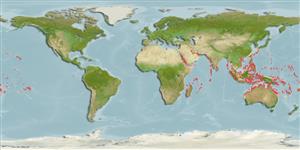Common names from other countries
Environment: milieu / climate zone / depth range / distribution range
Écologie
marin récifal; profondeur 0 - 18 m (Ref. 9710). Tropical; 32°N - 33°S, 32°E - 143°W
Indo-Pacific: Red Sea south to Maputo, Mozambique (Ref. 4421) and east to the Society and Tuamoto islands, north to the Gotô Islands, Japan (Ref. 559), south to the southern Great Barrier Reef.
Taille / Poids / Âge
Maturity: Lm ? range ? - ? cm
Max length : 20.0 cm TL mâle / non sexé; (Ref. 4421)
Description synthétique
Clés d'identification | Morphologie | Morphométrie
Épines dorsales (Total) : 2; Rayons mous dorsaux (Total) : 26 - 29; Épines anales: 0; Rayons mous anaux: 22 - 25. Body brown with up to 12 narrow dark brown crossbars; caudal fin dark brown; soft dorsal, anal and pectoral fins pale; lips dark brown (Ref. 4421). Males with numerous long spines in front of caudal peduncle; females with a toothbrush-like mass of setae (Ref. 1602).
Inhabits clear coastal to outer reefs, usually in rich coral areas with rubble patches or gutters (Ref. 48637). Feeds on coral polyps (Ref. 89972). Solitary or in pairs (Ref. 90102). Less approachable than most filefishes (Ref. 9710). Usually seeks coverage in large corals when approached (Ref. 48637). Minimum depth reported taken from Ref. 128797.
Life cycle and mating behavior
Maturities | Reproduction | Spawnings | Egg(s) | Fecundities | Larves
Myers, R.F., 1991. Micronesian reef fishes. Second Ed. Coral Graphics, Barrigada, Guam. 298 p. (Ref. 1602)
Statut dans la liste rouge de l'IUCN (Ref. 130435)
CITES (Ref. 128078)
Not Evaluated
Menace pour l'homme
Harmless
Utilisations par l'homme
Pêcheries: intérêt commercial mineur
Outils
Articles particuliers
Télécharger en XML
Sources Internet
Estimates based on models
Preferred temperature (Ref.
115969): 24.9 - 29.3, mean 28.3 (based on 2642 cells).
Phylogenetic diversity index (Ref.
82804): PD
50 = 1.0000 [Uniqueness, from 0.5 = low to 2.0 = high].
Bayesian length-weight: a=0.01995 (0.00943 - 0.04220), b=2.93 (2.75 - 3.11), in cm Total Length, based on LWR estimates for this (Sub)family-body shape (Ref.
93245).
Niveau trophique (Ref.
69278): 2.9 ±0.4 se; based on size and trophs of closest relatives
Résilience (Ref.
120179): Haut, temps minimum de doublement de population inférieur à 15 mois (Preliminary K or Fecundity.).
Fishing Vulnerability (Ref.
59153): Low vulnerability (10 of 100).
